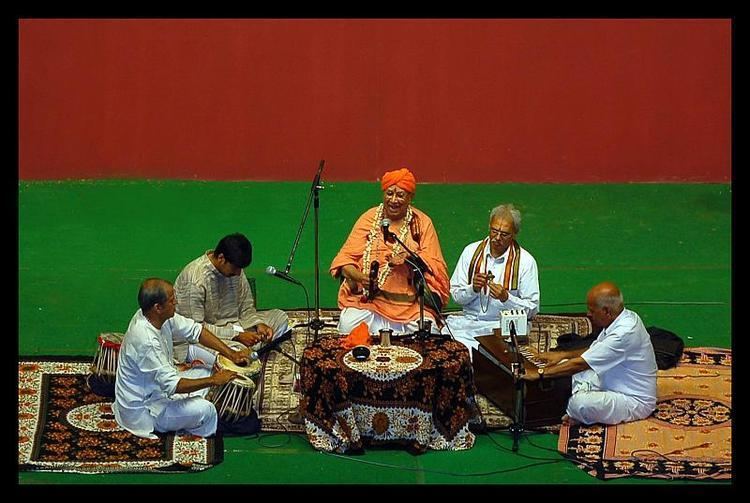 | ||
Music awards Filmfare AwardsPunjabi Music AwardsSangeet Natak Akademi Award Music festivals Saptak Festival of MusicChennai Music SeasonDover Lane music festivalTyagaraja Aradhana Music media SrutiThe Record Music Magazine | ||
Harikatha (Harikathe in Kannada), literally " Stories of Hari(Narayana)", also known as Katha Kaalakshepa ("Katha storytelling" - Spending time with kathe), is a form of Hindu religious discourse in which the storyteller explores a religious theme, usually the life of a saint or a story from an Indian epic.
Contents
Harikatha is a composite art form composed of storytelling, poetry, music, drama, dance, and philosophy. Any Hindu religious theme may be the subject for the Harikatha. At its peak Harikatha was a popular medium of entertainment, which helped transmit cultural, educational and religious values to the masses.
The main aim of Hari Katha is to imbue truth and righteousness in the minds of people and sow the seeds of devotion in them. Another of the aims is to educate them about knowledge of self (atman) through stories and show them the path of liberation.
In Hindu mythology
In Hindu mythology, the first Harikatha singer was sage Narada who sang for Vishnu, other prominent singers were Lava and Kusha twin sons of Rama, who sang the Ramayana in his court at Ayodhya.
History
Telugu Harikatha originated in Coastal Andhra during the 19th century. Harikatha Kalakshepam is most prevalent in Andhra even now along with Burra katha. Haridasus going round villages singing devotional songs is an age-old tradition during Dhanurmaasam preceding Sankranti festival. Ajjada Adibhatla Narayana Dasu was the originator of the Telugu Harikatha tradition, and with his Kavyas and Prabandhas has made it a special art form.
Style
Harikatha involves the narration of a story, intermingled with various songs relating to the story. Usually the narration involves numerous sub-plots and anecdotes, which are used to emphasise various aspects of the main story. The main story teller is usually assisted by one or more co-singers, who elaborate the songs and a Mridangam accompanist. The storyteller uses a pair of cymbals to keep beat.
Famous exponents
Following Krishna Bhagavatar, other great exponents of this art form such as Pandit Lakshmanachar, Tirupazhanam Panchapakesa Bhagavatar, Mangudi Chidambara Bhagavatar, Muthiah Bhagavatar, Tiruvaiyyar Annasami Bhagavatar, Embar Srirangachariyar, Konnoor Sitarama Shastry, Sulamangalam Vaidyanatha Bhagavatar, Sulamangalam Soundararaja Bhagavatar, Ajjada Adibhatla Narayana Dasu, Embar Vijayaraghavachariar, Saraswati Bai and Padmasini Bai popularized the Harikatha tradition.
Saraswati Bai was a pioneering woman Harikatha exponent. She broke the monopoly of Brahmin men over this art form. This was attested by F. G. Natesa Iyer (in 1939) who said: “Saraswati Bai is a pioneer, and today, as a result of her sacrifices…. Brahmins and non-Brahmins walk freely over the once forbidden ground. C. Saraswati Bai has achieved this miracle.”
Paruthiyur Krishna Sastri started out as a Harikatha exponent and then changed to Pravachan style. Recent practitioners of Harikatha include Veeragandham Venkata Subbarao, Kota Sachchidananda Sastri, Mannargudi Sambasiva Bhagavatar, Banni Bai, Mysore Sreekantha Shastry, Kamala Murthy, Embar Vijayaraghavachariar, Kalyanapuram Aravamudachariar, Dushyanth Sridhar, Gururajulu Naidu, and T S Balakrishna Sastry.
